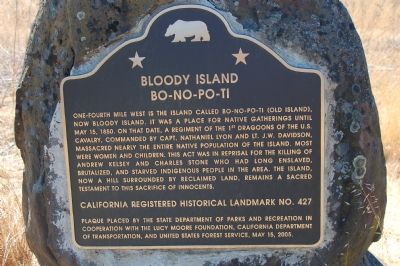From Wikipedia, the free encyclopedia
The Bloody Island Massacre (also called the Clear Lake Massacre) occurred on an island called Bo-no-po-ti, Badon-napo-ti, or "Old Island", at the north end of Clear Lake, Lake County, California on May 15, 1850.[1][2]
A number of Pomo Indians, primarily members of the Hoolanapo clan, had been enslaved and abused by settlers Andrew Kelsey -- whose name is still attached to the town of Kelseyville today -- and Charles Stone. Kelsey and Stone had purchased a cattle ranch from Salvador Vallejo in 1847. They captured and impressed local Pomos to work as vaqueros on the ranch. Their treatment of the Pomo were more brutal than Vallejo's. Families starved on meager rations, as the men only provided four cups of wheat a day for a family. One young man was sent by his family to ask for more wheat and Stone killed him.[3]
In the fall of 1849, Kelsey forced 50 Pomo men to work as laborers on a gold seeking expedition, and only one or two men returned alive.[4]
After this travesty, Stone and Kelsey beat and even shot Pomo men and raped Pomo women. The wife of Chief Augustine was raped, and the tribe responded with an attack. Augustine's wife poured water onto the two men's gun powder, rendering it useless, then warriors, including Pomo men Suk and Xasis, attacked the house at dawn, immediately killing Kelsey with an arrow. Stone jumped out a window and tried to hide in a stand of willow trees, but Augustine founded him and killed him with a rock. Then the Pomo men took food back to their families.[3]
A 1st Dragoons Regiment of the United States Cavalry contingent under General Nathaniel Lyon, who at that time was still a lieutenant, and Lieutenant J. W. Davison[2] tried in vain to located Augustine's band to retaliate.
Instead they came upon another group of Pomos on Bonopoti or Bloody Island and slaughtered almost the entire population of the island,[2] including women and children. Some of those killed were relatives of the Habematolel Pomo of Upper Lake[1] and Robinson Rancheria of Pomo Indians of California. Estimates of the number of people killed on the island vary between 60 and 400. The army then killed 75 more Indians along the Russian River.[3]
One of the few Pomo survivors of the massacre was a 6-year-old girl named Ni'ka or Lucy Moore. She survived by hiding under the lake waters and breathing through a tule reed. Her descendants formed the Lucy Moore Foundation.[3]
Later, the Pomo were forced to live in small "rancherias" set aside by the federal government. For most of the 20th century, the few Pomo people left had to live on these tiny reservations in poverty. It should be noted that very few textbooks on California history even mention the Bloody Island incident or the subsequent abuse of native Californians.




Leave a comment